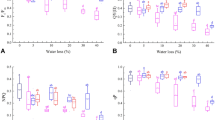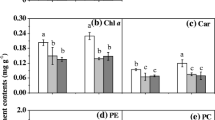Abstract
Pyropia yezoensis, an intertidal seaweed, experiences regular dehydration and rehydration with the tides. In this study, the responses of P. yezoensis to dehydration and rehydration under high and low CO2 concentrations ((600–700)×10−6 and (40−80)×10−6, named Group I and Group II respectively) were investigated. The thalli of Group I had a significantly higher effective photosystem II quantum yield than the thalli of Group II at 71% absolute water content (AWC). There was little difference between thalli morphology, total Rubisco activity and total protein content at 100% and 71% AWC, which might be the basis for the normal performance of photosynthesis during moderate dehydration. A higher effective photosystem I quantum yield was observed in the thalli subjected to a low CO2 concentration during moderate dehydration, which might be caused by the enhancement of cyclic electron flow. These results suggested that P. yezoensis can directly utilize CO2 in ambient air during moderate dehydration.
Similar content being viewed by others
References
Adams J B, Bate G C. 1994. The tolerance to desiccation of the submerged macrophytes Ruppia cirrhosa (Petagna) grande and Zostera capensis setchell. J. Exp. Mar. Biol. Ecol., 183: 53–62.
Assmann S M, Snyder J A, Lee Y R J. 2001. ABA-deficient (aba1) and ABA-insensitive (abi1-1, abi2-1) mutants of arabidopsis have a wild-type stomatal response to humidity. Plant Cell Environ., 23: 387–395.
Bjork M, Uku J, Weil A, Beer S. 1999. Photosynthetic tolerances to desiccation of tropical intertidal seagrasses. Mar. Ecol. Prog. Ser., 191: 121–126.
Bradford M M. 1976. A rapid and sensitive method for the quantitation of microgram quantities of protein utilizing the principle of protein-dye binding. Anal. Biochem., 72: 248–254.
Bukhov N, Carpentier R. 2004. Alternative photosystem I-driven electron transport routes: mechanisms and functions. Photosynth. Res., 82: 17–33.
Davison I R, Pearson G A. 1996. Stress tolerance in intertidal seaweeds. J. Phycol., 32: 197–211.
Gao K S, Aruga Y, Asada K, Ishihara T, Akano T, Kiyohara M. 1991. Enhanced growth of the red alga Porphyra yezoensis Ueda in high CO2 concentrations. J. Appl. Phycol., 3: 355–362.
Gao K S, Aruga Y. 1987. Preliminary studies on the photosynthesis and respiration of Porphyra yezoensis under emersed conditions. J. Tokyo Univ. Fish., 47: 51–65.
Gao K S, Ji Y, Aruga Y. 1999. Relationship of CO2 concentrations to photosynthesis of intertidal macroalgae during emersion. Hydrobiologia, 398–399: 355–359.
Gao S, Wang G C. 2012. The enhancement of cyclic electron flow around photosystem I improves the recovery of severely desiccated Porphyra yezoensis (Bangiales, Rhodophyta). J. Exp. Bot., http://dx.doi.org/10.1093/jxb/ers082.
Gerard V A, Driscoll T. 1996. A spectrophotometric assay for Rubisco activity: application to the kelp Laminaria saccharina and implications for radiometric assays. J. Phycol., 32: 880–884.
Hodgson L M. 1981. Photosynthesis of the red alga Gastroclonium coulteri (Rhodophyta) in response to changes in temperature, light intensity, and desiccation. J. Phycol., 17: 37–42.
Johnston A M, Raven J A. 1986. The analysis of photosynthesis in air and water of Ascophyllum nodosum (L.) Le Jol. Oecologia, 69: 288–295.
Kawamitsu Y, Driscoll T, Boyer J S. 2000. Photosynthesis during desiccation in an intertidal alga and a land plant. Plant Cell Physiol., 41: 344–353.
Kramer D M, Johnson G, Kiirats O, Edwards G E. 2004. New fluorescence parameters for the determination of QA redox state and excitation energy fluxes. Photosynth. Res., 79(2): 209–218.
Larsson C, Axelsson L. 1999. Bicarbonate uptake and utilization in marine macroalgae. Eur. J. Phycol., 34: 79–86.
Leuschner C, Landwehr S, Mehlig U. 1998. Limitation of carbon assimilation of intertidal Zostera noltii and Z. marina by desiccation at low tide. Aquat. Bot., 62: 171–176.
Lignell A, Pedersén M. 1989. Effects of pH and inorganic carbon concentration on growth of Gracilaria secundata. Br. Phycol. J., 24: 83–89.
Lin A P, Wang G C, Yang F, Pan G H. 2009. Photosynthetic parameters of sexually different parts of Porphyra katadai var. hemiphylla (Bangiales, Rhodophyta) during dehydration and re-hydration. Planta, 229: 803–810.
Lipkin Y, Beer S, Eshel A. 1993. The ability of Porphyra linearis (Rhodophyta) to tolerate prolonged periods of desiccation. Bot. Mar., 36: 517–523.
Ma J H, Cai S Q. 1996. The Cultivation and Processing of Porphyra yezoensis Ueda. Science Press, Beijing, China. p.12–182. (in Chinese)
Maberly S C. 1990. Exogenous sources of inorganic carbon for photosynthesis by marine macroalgae. J. Phycol., 26: 439–449.
Madsen T V, Maberly S C. 1990. A comparison of air and water as environments for photosynthesis by the intertidal alga Fucus spiralis (Phaeophyta). J. Phycol., 26: 24–30.
Mercado J, Javier F, Gordillo L, Xavier Niell F, Figueroa F. 1999. Effects of different levels of CO2 on photosynthesis and cell components of the red alga Porphyra leucosticta. J. Appl. Phycol., 11: 455–461.
Mott K A, Parkhurst D F. 1991. Stomatal responses to humidity in air and helox. Plant Cell Environ., 14: 509–515.
Pérez-Lloréns J L, Niell F X. 1993. Temperature and emergence effects on the net photosynthesis of two Zostera noltii Hornem. morphotypes. Hydrobiologia, 254: 53–64.
Quadir A, Harrison P J, Dewreede R E. 1979. Effects of emergence and submergence on the photosynthesis and respiration of marine macrophytes. Phycologia, 18: 83–88.
Sampath-Wiley P, Neefus C D, Jahnke L S. 2008. Seasonal effects of sun exposure and emersion on intertidal seaweed physiology: fluctuations in antioxidant contents, photosynthetic pigments and photosynthetic efficiency in the red alga Porphyra umbilicalis kutzing (Rhodophyta, Bangiales). J. Exp. Mar. Biol. Ecol., 361: 83–91.
Schreiber U. 2004. Pulse-amplitude-modulation (PAM) fluorometry and saturation pulse method: an overview. In: George C P ed. Chlorophyll a Fluorescence: A Signature of Photosynthesis. Springer, Dordrecht. p.279–319.
Seddon S, Cheshire A C. 2001. Photosynthetic response of Amphibolis antarctica and Posidonia australis to temperature and desiccation using chlorophyll fluorescence. Mar. Ecol. Prog. Ser., 220: 119–130.
Zou D H, Gao K S. 2002. Effects of desiccation and CO2 concentrations on emersed photosynthesis in Porphyra haitanensis (Bangiales, Rhodophyta), a species farmed in China. Eur. J. Phycol., 37: 587–592.
Author information
Authors and Affiliations
Corresponding author
Additional information
Supported by the Science and Technology Strategic Pilot Program of Chinese Academy of Sciences (No. XDA11020404), the National High Technology Research and Development Program of China (863 Program) (No. 2012AA100806), the Tianjin Natural Science Foundation (No. 12JCZDJC22200), and the Project for Developing Marine Economy by Science and Technology in Tianjin (No. KX2010-0005)
ZHOU Wei, HE Linwen, and YANG Fang contributed equally to this work.
Rights and permissions
About this article
Cite this article
Zhou, W., He, L., Yang, F. et al. Pyropia yezoensis can utilize CO2 in the air during moderate dehydration. Chin. J. Ocean. Limnol. 32, 358–364 (2014). https://doi.org/10.1007/s00343-014-3093-7
Received:
Accepted:
Published:
Issue Date:
DOI: https://doi.org/10.1007/s00343-014-3093-7




